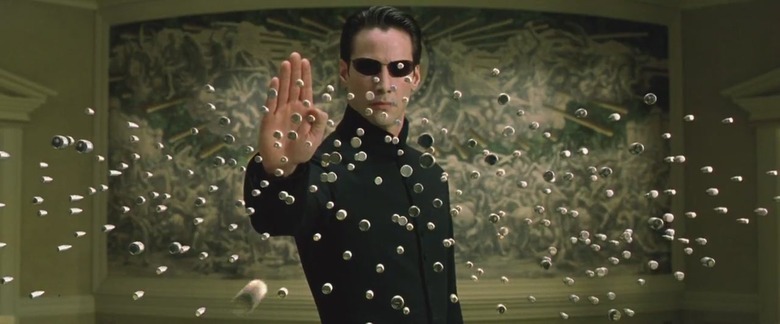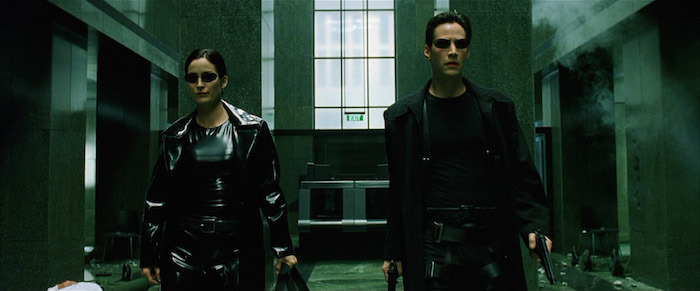The Wachowskis' Post-Corporeal Future: How 'Sense8' Ties The Duo's Entire Filmography Together
Lana and Lilly Wachowski have always been bold, innovative, and constantly surprising. They're best known for their Matrix blockbusters, of course, while their audacious box office flops Speed Racer, Cloud Atlas, and Jupiter Ascending confounded expectations and helped create a profoundly idiosyncratic body of work that many struggled to pigeonhole. But the last few years have reframed their filmography in exciting ways.Sense8, now complete on Netflix, brings together themes that have permeated the Wachowskis' work for decades, and their coming-out as trans women puts their entire oeuvre into a new context. Suddenly, all these big-budget effects spectacles click into thematic sync. It all stems from the relationship between the body, the mind, and the soul – the self the world sees, versus the self inside.
A Prison for Your Mind
No Wachowski creation is as visible or popular as The Matrix. Their breakout sophomore directing effort sets up a hell of a dystopian future: the human race is kept unconscious in captivity, used as energy sources for a race of machines, their minds kept occupied with a simulated reality known as the Matrix. Real-world existence is miserable, but in the virtual world, people live an approximation of late 20th century life – or, if freed from the Matrix, fight back with spectacular abilities.Mind and body are separate in The Matrix, but they're not equal. Would-be prophet Morpheus states unequivocally that "the body cannot exist without the mind," and the rest of the film absolutely privileges the mind over the body – the body is a limitation, if anything. Freed minds in the Matrix are its most powerful entities, bending virtual physics and manipulating reality itself. Moreover, characters' appearances within the Matrix are defined by what Morpheus refers to as "residual self-image."This is a big deal. It's barely touched on, mostly used to clothe Neo and friends in fancy duds, but residual self-image is one of the film's best ideas. Switch, portrayed by Belinda McCrory, was originally written as male in the real world and female in the Matrix, suggesting that people could project an inner identity wholly distinct from their physical self. Warner Bros mandated that Switch maintain her gender between worlds, but the directors' intentions remain in the character's androgynous appearance. It's a shame this wasn't developed; it's an intriguing twist on online anonymity, and an early demonstration of the Wachowskis' queer leanings.
The Future is Our Time
The flip side of The Matrix's post-corporeality can be seen in the Agents, programs that can invade the digital projections of anyone still hardwired to the Matrix. For the Agents, human beings are just vessels for their own use, their consciousnesses disposable and interchangeable. But it's the Matrix sequels that truly dive into the culture of the programs that built and inhabit the digital dream. The Matrix Reloaded and Revolutions grant programs sentience, agency, and even independent hopes and dreams. In this new paradigm, the Agents are mere computer cops, working unquestioningly for the digital Man, policing other programs as much as they do renegade humans.Programs don't have bodies, of course – they exist only in software – but the Matrix sequels treat digital characters like the Oracle, the Keymaker, and young Sati with as much care as they do humans. That speaks to the series' separation of the mental and physical self, reframing the Matrix into a digital ecosystem inhabited by unique life forms. Only Agent Smith seeks to brute-force his way into the real world; his commandeering of a human body is presented as the height of arrogance and psychopathy. The body cannot exist without the mind, but the Matrix sequels present a world in which minds can exist without bodies.
Our Lives Are Not Our Own
2012's mega-ambitious Cloud Atlas evolved the Wachowskis' ideas in a direction that would ultimately lead to Sense8. Based on David Mitchell's quasi-anthology novel, Cloud Atlas tells six stories simultaneously, each with its own protagonist, across time periods ranging from the 1840s to a post-apocalyptic future. These characters may be genetically unrelated, but they are spiritually connected, as indicated by a comet-shaped birthmark, a thirst for truth and justice, and a matching series of narrative beats.Through this connection, Cloud Atlas implies that all human lives are intrinsically linked in ways we may not understand. One constant spirit exists in all these protagonists, the film posits, just as they're locked in parallel struggles that repeat across the eons. "From womb to tomb, we are bound to others, past and present," proselytises Doona Bae's Sonmi-451, "and by each crime and every kindness, we birth our future." And so it is. The archetypes, events, and conflicts cycling throughout history reinforce Sonmi's mantra that "our lives are not our own."Further supporting this idea is the film's casting, which sees the same troupe of actors populating the roles in every time period. Each protagonist is played by a different performer, but nearly every cast member pops up again and again, sometimes even in differing gender roles. Archetypes and faces recur across time, losing individuality but gaining mythic significance. This blurring of the sense of self, both in appearance and across time and space, would become even more central in the Wachowskis' work to come.
Human Resources
The Wachowskis' most recent feature, Jupiter Ascending, plays with an inversion of their usual themes. In amongst the anti-gravity roller blades, space-dragons, and royal bowels, there's a surprisingly dark science fiction story at play. To the spacefaring humans of this universe, DNA has an almost spiritual significance, to the point that recurrence of the same genes is considered equivalent to reincarnation. Mila Kunis' Jupiter is, according to this set of beliefs, the reincarnation of a legendary galactic queen – all by virtue of a genetic sequence with which she feels little affinity. In this sense, the film flips Cloud Atlas' spirituality on its head, but it doesn't stop there.Jupiter Ascending reveals a dark side to the Wachowskis' more transcendental recurring themes. Its evil corporation Abrasax represents a galaxy-spanning industry that seeds planets with human life, then harvests their genetic material, killing entire populations. Those wealthy enough to afford it can use the resultant fluid to de-age themselves, extending their lives for millennia. For all its talk of reincarnation and life extension, the wealthy society of Jupiter Ascending sees human lives as expendable. "Some lives will always matter more than others," explains Tuppence Middleton's Kalique. The Abrasax family's eternally supple bodies are all cosmetics; their souls rot within.Human bodies are used again and again as commodities in the Wachowskis' filmography. The Matrix, most famously, sees the whole of humanity turned into a power source for the machines that rule the planet. Cloud Atlas depicts exploitation across the ages, from 19th-century slavery to a futuristic society that clones humans as "fabricant" servants – and feeds them with their recycled dead. And in Jupiter Ascending, people serve as raw materials for a precious medical treatment, millions dying so that the rich and powerful might live forever.This is a perfect mirror image to the themes of The Matrix and Cloud Atlas. If the body is just a vessel for the mind, it follows that it can also serve, bluntly, as a biological resource. The problem lies in the fact that harvesting those bodies tends to kill the person inside them. Only The Matrix's machines manage a balance: while humanity is still technically enslaved, their minds exist contentedly enough while their bodies supply energy for their mechanical overlords. Not the best life, but it's better than being turned into Space Botox.
I am Also a We
All of this brings us to Sense8: a longform Netflix experiment and a culmination of the Wachowskis' screen obsessions. Just as ambitious and striking as Cloud Atlas or The Matrix, Sense8 follows eight "sensates" who find themselves linked to one another, through a kind of full-spectrum telepathy. The show is remarkable for its juggling of storylines, cast, and budget-blowing locations alone, but it's the unique relationship between the sensates that conjure true magic.Sense8's core conceit sees its eight main characters joined as one, experiencing each other's worlds, sensations, and emotions as if they were their own. Their bond goes beyond mere communication; their sense of self detaches and expands to include others, redefining the bounds of empathy. That these characters are all wildly different is vitally important: if these people can learn to understand one another, then perhaps we can learn to understand the people with which we share our world.That understanding goes hand-in-hand with another key theme. Queerness had always sat at the sidelines of the Wachowskis' films – in Bound's lesbian affair, V For Vendetta's executed prisoner Valerie Page, Cloud Atlas' gay composer Robert Frobisher, and even the more hedonistic bits of Jupiter Ascending – but Sense8 foregrounds it. One sensate is a trans woman in a longterm relationship; another, a polyamorous gay man; another, a woman implied to have had relationships with both men and women at various points. A major sequence is set at a Pride parade. The series even culminates in a fireworks-laden same-sex wedding on the Eiffel Tower, followed by one of the hottest and most emotional orgy sequences in a series that can boast a few.Since Lana and Lilly came out as trans women, their work has demanded re-evalutation. Whether literally, via Sense8's trans woman Nomi Marks; visually, in Cloud Atlas' gender-bent casting; or metaphorically, in The Matrix's core conceit, it sports a consistent thread of separating identity from physicality. Queerness and transhumanism go hand in hand, in this respect: they represent a critical approach to social norms, and to the bodies we're given. That the Wachowskis' stories often deal with revolution and rebellion feels like no accident either – the directors' assertion of their identities is itself an act of rebellion in a world that doesn't yet fully understand or accept them.The person inside is more real than the one outside, state these films: a trite message from any other director, but a profound one coming from the Wachowskis.
Whoa
As far as unifying theses go, this one's got gaps. Speed Racer, for example, is a vastly underrated, anime-fueled confection, but its automotive-industry parable sticks out thematically from the rest the sisters' filmography. Ditto V For Vendetta, which the Wachowskis wrote and produced: though its title character is less a man than an idea, it's a fairly straightforward tale of revolution. And early neo-noir Bound may centre on a queer love affair, but it lacks the fantastical elements of later work. Still, though, the Wachowskis' 20-plus year filmography has plenty of throughlines.Transhumanism isn't a new idea in science fiction, but the Wachowskis bring life to the subgenre that few others have. Rather than treating the concept as a coldly intellectual exercise, the Wachowskis use transhumanism as a truly personal form of expression. Cloud Atlas and Sense8, especially, are achingly emotional works, baring their creators' hearts in a disarmingly intimate way.Looking back, the ideas in The Matrix are more subversive than anyone gave them credit for at the time. The Wachowskis' favourite themes – rebellion, empathy, queerness, camaraderie, and expanding the mind – all click together now. These filmmakers are trailblazers not just in terms of LGBT visibility, but in their use of popular genre entertainment to express it. In the futures envisioned by the Wachowskis, humanity is capable of terrible things, as always – but it's also capable of transcending its physical limitations to become something greater.We should treasure these women's optimism, their inventiveness, and their will to speak to the inner goodness of their audience. Long may they continue to work.






